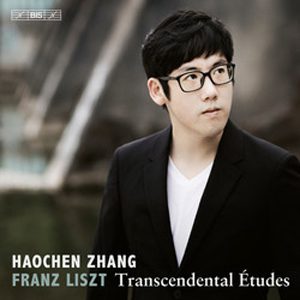Haochen Zhang’s Liszt Transcendental Etudes are bound to attract intense scrutiny, in light of these works’ recent proliferation in the catalog and Zhang’s growing prominence on the international piano scene. The brief opening Prelude’s individual touches are totally borne out by the score: such as the accented ascending left-hand lines, or how the marcatissimo chords take on a slashing ferocity when played strictly in tempo, as opposed to the broadening one hears from most pianists.
Some may find the second etude too compulsively detailed where inner voices sometimes stick out to a fault, while the upward leggermente triplets are on the careful, studio-bound side. It takes a while for Paysage’s long lines to truly resonate and soar. Mazeppa’s thickets of notes hold no difficulties for Zhang’s technique, yet his clattery, undifferentiated textural layering pales next to the extraordinary three-dimensional perspectives revealed in Yunchan Lim’s 2022 Van Cliburn Competition semi-finals performance.
Happily, Zhang’s fusion of breathtaking speed and felicitous poetry make for a Feux Follets worthy to mention alongside those of Sviatoslav Richter and Minoru Nojima. The pianist builds Vision in steadily moving blocks, and wisely starts out less loudly than Liszt indicates in order for the fortes and fortissimos to make a stronger impact. He takes more than usual dramatic advantage of Eroica’s fermatas, while his muted deliberation in the main section transforms the music into more of a funeral than military march.
To my ears, Zhang’s swiftness and clipped articulation in Wilde Jagd’s broken octaves and rapid-fire chords evokes not so much a royal hunt as a Road Runner cartoon. However, the lyrical Ricordanza features some of Zhang’s most direct, and stingingly proportioned pianism in the cycle. His forthright pacing and wide dynamic scope in Harmonies du Soir convey a similar impression. While it’s impressive how Zhang shapes and controls No. 10 to the extent that he does with little help from the sustain pedal, the effects draw more attention to themselves rather than to the music’s underlying agitato subtext. By contrast, the pianist’s variety of touch and timbre minimizes the tremolo texture’s potential for fatigue and monotony.
In sum, you may not agree with all of Zhang’s interpretive decisions, yet he clearly is a thinking and often stimulating virtuoso who leaves a strong imprint on these oft-recorded works. With that in mind, I prefer the conceptual consistency and more settled musicality of an earlier BIS Liszt Etudes from pianist Laszlo Simon (a/k/a Joyce Hatto, for those who remember the scandal we helped to uncover back in 2007). I also should mention that Yunchan Lim’s stunning Liszt cycle from the Cliburn is imminent from Steinway & Sons, hence its inclusion among the reference versions.
































